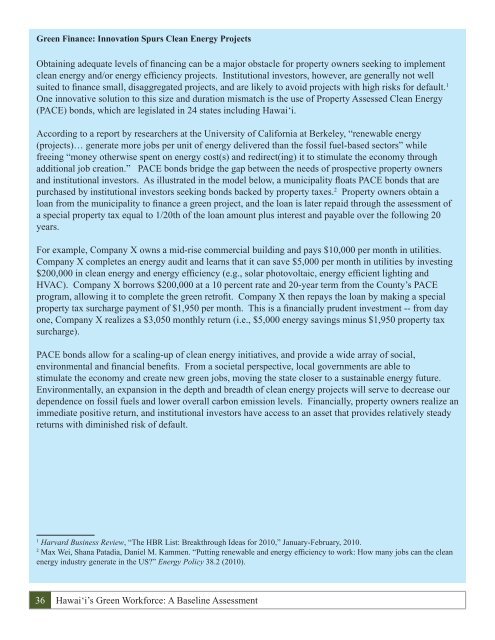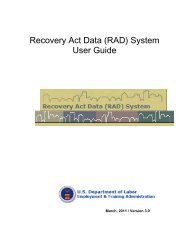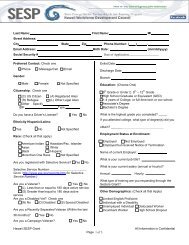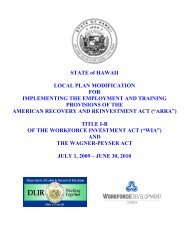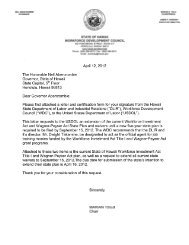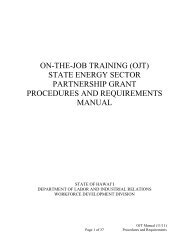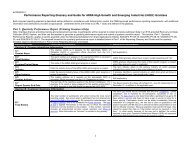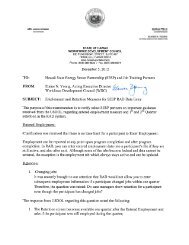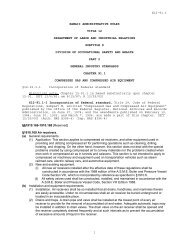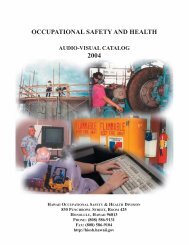Hawai i's Green Workforce A Baseline Assessment December 2010
Hawai i's Green Workforce A Baseline Assessment December 2010
Hawai i's Green Workforce A Baseline Assessment December 2010
You also want an ePaper? Increase the reach of your titles
YUMPU automatically turns print PDFs into web optimized ePapers that Google loves.
<strong>Green</strong> Finance: Innovation Spurs Clean Energy Projects<br />
Obtaining adequate levels of financing can be a major obstacle for property owners seeking to implement<br />
clean energy and/or energy efficiency projects. Institutional investors, however, are generally not well<br />
suited to finance small, disaggregated projects, and are likely to avoid projects with high risks for default. 1<br />
One innovative solution to this size and duration mismatch is the use of Property Assessed Clean Energy<br />
(PACE) bonds, which are legislated in 24 states including <strong>Hawai</strong>ÿi.<br />
According to a report by researchers at the University of California at Berkeley, “renewable energy<br />
(projects)… generate more jobs per unit of energy delivered than the fossil fuel-based sectors” while<br />
freeing “money otherwise spent on energy cost(s) and redirect(ing) it to stimulate the economy through<br />
additional job creation.” PACE bonds bridge the gap between the needs of prospective property owners<br />
and institutional investors. As illustrated in the model below, a municipality floats PACE bonds that are<br />
purchased by institutional investors seeking bonds backed by property taxes. 2 Property owners obtain a<br />
loan from the municipality to finance a green project, and the loan is later repaid through the assessment of<br />
a special property tax equal to 1/20th of the loan amount plus interest and payable over the following 20<br />
years.<br />
For example, Company X owns a mid-rise commercial building and pays $10,000 per month in utilities.<br />
Company X completes an energy audit and learns that it can save $5,000 per month in utilities by investing<br />
$200,000 in clean energy and energy efficiency (e.g., solar photovoltaic, energy efficient lighting and<br />
HVAC). Company X borrows $200,000 at a 10 percent rate and 20-year term from the County’s PACE<br />
program, allowing it to complete the green retrofit. Company X then repays the loan by making a special<br />
property tax surcharge payment of $1,950 per month. This is a financially prudent investment -- from day<br />
one, Company X realizes a $3,050 monthly return (i.e., $5,000 energy savings minus $1,950 property tax<br />
surcharge).<br />
PACE bonds allow for a scaling-up of clean energy initiatives, and provide a wide array of social,<br />
environmental and financial benefits. From a societal perspective, local governments are able to<br />
stimulate the economy and create new green jobs, moving the state closer to a sustainable energy future.<br />
Environmentally, an expansion in the depth and breadth of clean energy projects will serve to decrease our<br />
dependence on fossil fuels and lower overall carbon emission levels. Financially, property owners realize an<br />
immediate positive return, and institutional investors have access to an asset that provides relatively steady<br />
returns with diminished risk of default.<br />
1 Harvard Business Review, “The HBR List: Breakthrough Ideas for <strong>2010</strong>,” January-February, <strong>2010</strong>.<br />
2 Max Wei, Shana Patadia, Daniel M. Kammen. “Putting renewable and energy efficiency to work: How many jobs can the clean<br />
energy industry generate in the US?” Energy Policy 38.2 (<strong>2010</strong>).<br />
36 <strong>Hawai</strong>ÿi’s <strong>Green</strong> <strong>Workforce</strong>: A <strong>Baseline</strong> <strong>Assessment</strong>


